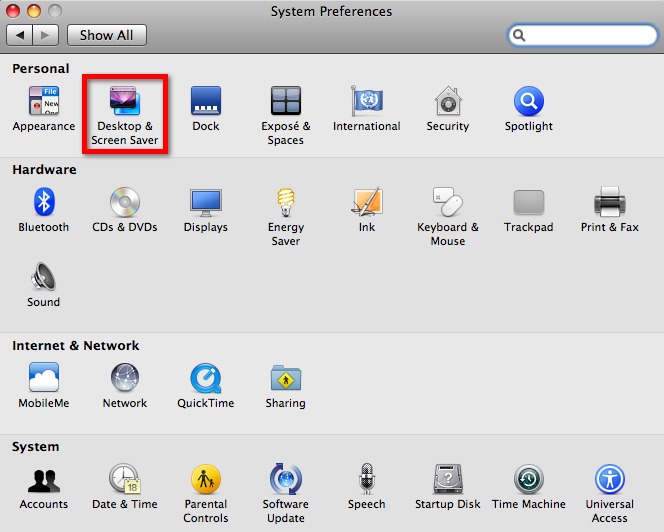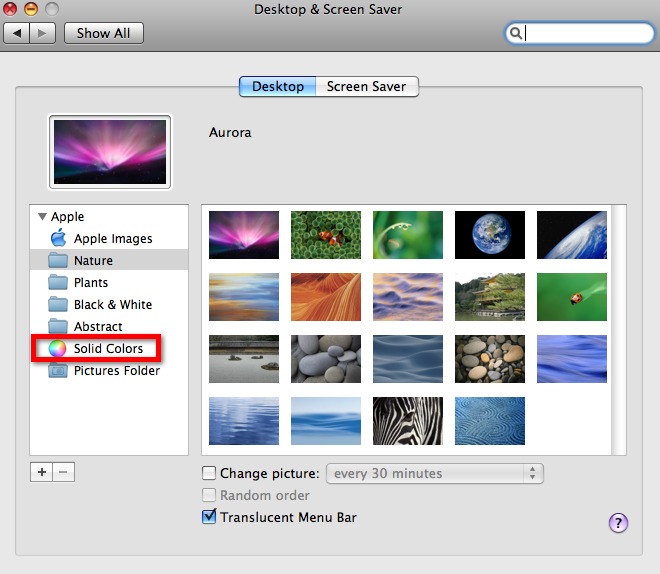- Using the high contrast colour scheme
- Changing the desktop background colour
Note: Mac key convention: ‘Ctrl’ ' is used for ‘Control’, ‘Apple’ is used for ‘Command’ and ‘Alt’ is used for the ‘Option’ key.
Note: For keyboard access make sure ‘Full keyboard access’ is turned on - you can turn it on or off; by pressing ‘Ctrl’ + ‘F1’ at any time.
Using the high contrast colour scheme
Step 1
- Make sure you are in ‘Finder’, press ‘Apple’ + ‘Tab’ if necessary to cycle through open applications until you return to ‘Finder’.
- Click on the ‘Apple’ menu or press ‘Ctrl’ + ‘F2’
- Click on ‘System Preferences...’ as shown in Fig 1 or press the down arrow key to highlight it and then press ‘Enter’.

Fig 1
Step 2
- Click to select ‘Universal Access’ or ‘Tab’ repeatedly (you might need to press ‘Ctrl’ + ‘F7’ first) to cycle through the icons until the ‘Universal Access’ icon is selected and then press the ‘Spacebar’, Fig 2.

Fig 2
- Click to select ‘Seeing’ or press ‘Ctrl’ + ‘F7’ to highlight one of the four tabs for example ‘Keyboard’ and then press the left or right arrow key to select the ‘Seeing’ tab.
- To change to a high contrast white on black colour scheme click on the ‘Switch to White on Black’ radio button in Fig 3 or press ‘Tab’ to select and the arrow up or down.
- The colour scheme will change straight away, to switch between the high contrast and standard display scheme at any time press ‘Shift’ + ‘Alt’ + ‘Apple’ + ‘8’.
- To increase or decrease the contrast level at any time press ‘Shift’ + ‘Alt’ + ‘Apple’ + ‘.’ (period) to increase contrast and ‘Shift’ + ‘Alt’ + ‘Apple’ + ‘,’ (comma) to decrease the contrast.

Fig 3
You also have the option to set the display to grayscale, to do this
- Follow steps 1 and 2 above.
- Click on the ‘Set Display to Grayscale’ checkbox or press ‘Tab’ to highlight the ‘Set Display to Grayscale’ checkbox and press the ‘Spacebar’, Fig 3.
- The colour scheme will change straight away to turn it back to the standard display click again on ‘Set Display to Grayscale’ or press ‘Tab’ to select and press ‘Spacebar’.
Step 3
- When you are happy with your choice click on the Desktop window's close button or press ‘Apple’ + ‘W’.
Changing the desktop background colour
Step 1
- Make sure you are in ‘Finder’, press ‘Apple’ + ‘Tab’ if necessary to cycle through open applications until you return to ‘Finder’.
- Click on the ‘Apple’ menu or press ‘Ctrl’ + ‘F2’.
- Click on ‘System Preferences...’ as shown in Fig 1 or press the down arrow key to highlight it and then press ‘Enter’.
- Click to select ‘Desktop and Screensaver’ or press ‘Tab’ repeatedly (you might need to press ‘Ctrl’ + ‘F7’ first) to cycle through the icons until the ‘Desktop and Screensaver’ icon is highlighted and then press the ‘Spacebar’, Fig 4.

Fig 4
Step 2
Click on ‘Desktop’ or ‘Tab’ until is selected then press the ‘Spacebar’.
- Click on ‘Solid Colors’ in the ‘Apple’ folder as shown in Fig 5 or press the ‘Tab’ key to select the left hand list of choices (directories) then use the up and down arrow keys to highlight it and then press the ‘Spacebar’.
- Click on a colour you want (no keyboard shortcut). You will see that as soon as you make a choice the background colour changes straight away.

Fig 5
Step 3
- When you are happy with your choice click on the Desktop window's close button or press ‘Apple’ + ‘W’.
Note: If this does not work it could be because your computer settings cannot be changed due to local IT policies - contact your local IT support for further help.
Need some more help?
Call our helpline 0300 180 0028 or email enquiries@abilitynet.org.uk
Need free IT Support at Home?
If you are older or disabled and need IT support at home, you can book a free home visit.